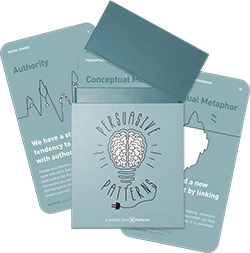IKEA effect
Design Pattern
Problem summary
We place a disproportionately high value on products we helped create
Usage
- Use to boost customer satisfaction by involving end users in part of the building or assembly process
- Use to make users more resistant to change from a particular project due to the sunk cost effect of having poured effort into a product, service, or project.
This card is part of the Persuasive Patterns printed card deck
The Persuasive Patterns Card Deck is a collection of 60 design patterns driven by psychology, presented in a manner easily referenced and used as a brainstorming tool.
Get your deck!Solution
- Increase customer satisfaction. Actively involve users in not only designing, marketing, and testing of products, but also building them, to maximize their satisfaction. Add an aspect of customer-owned creation into your existing product. The biggest challenge lies in convincing users to engage in the kinds of labor that will lead them to value products more highly.
- Find appropriate challenges. Labor leads to love only when that labor is successful. Be careful to create tasks that are not too difficult as to lead to an inability to complete the task. Start with low effort personalization options such as adding customization options and progress from there.
- Can lead to change aversion. We tend to over-commit to efforts in which we have previously invested just as we over-value products we have been part of building. This leads to our tendency to be less likely to abandon ideas or projects that we have previously put labor into.
Rationale
Allow customers to be involved in the creation of your product to establish a powerful emotional connection between the two. We will pay more for something we have put work into than if we bought it ready-made. Customers are willing to pay a premium for products they have customized. The effect is not simply due to the amount of time spent on the creations, as dismantling a previously built product will make the effect disappear.
The IKEA Effect can be explained by positive feelings of competence from completing a task, a focus on the product’s positive attributes3, a psychological sense of ownership4, and the relationship between effort & liking, effort & valuation, and between our relations & our self-concept2. The effect originated in the field of behavioral economics, but can similarly be explained by social psychology and self-determination theory.
1 Kruger, J., Wirtz, D., Van Boven, L., & Altermatt, T. W. (2004). The effort heuristic. Journal of Experimental Social Psychology, 40(1), 91-98.
2 Marsh, L. E., Kanngiesser, P., & Hood, B. (2018). When and how does labour lead to love? The ontogeny and mechanisms of the IKEA effect. Cognition, 170, 245-253.
3 Norton, M. I., Mochon, D., & Ariely, D. (2012). The IKEA effect: When labor leads to love. Journal of Consumer Psychology, 22, 453-460.
4 Sarstedt, M., Neubert, D., & Barth, K. (2017). The IKEA Effect. A conceptual replication. Journal of Marketing Behavior, 2(4), 307-312.
5 The IKEA Effect at Learning Loop
User Interface Design Patterns
- Forms
- Explaining the process
- Community driven
- Tabs
- Jumping in hierarchy
- Menus
- Content
- Gestures
- Tables
- Formatting data
- Images
- Search
- Reputation
- Social interactions
- Shopping
- Increasing frequency
- Guidance
- Registration
Persuasive Design Patterns
- Loss Aversion
- Other cognitive biases
- Scarcity
- Gameplay design
- Fundamentals of rewards
- Gameplay rewards
